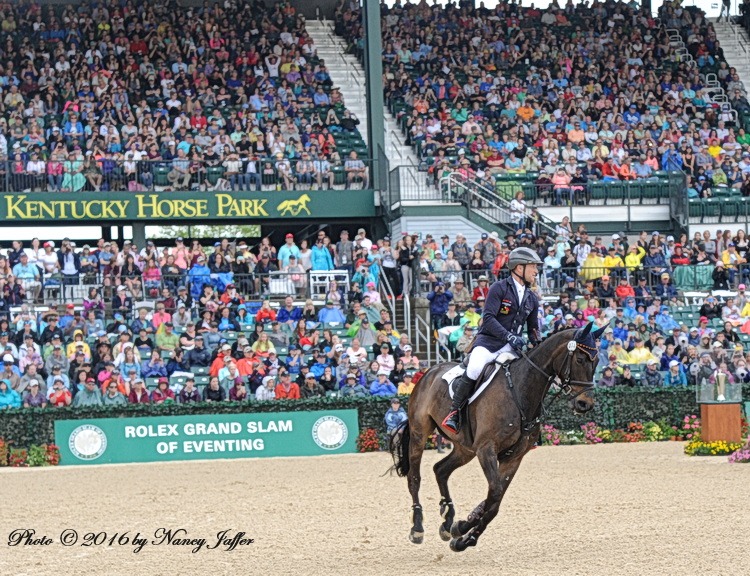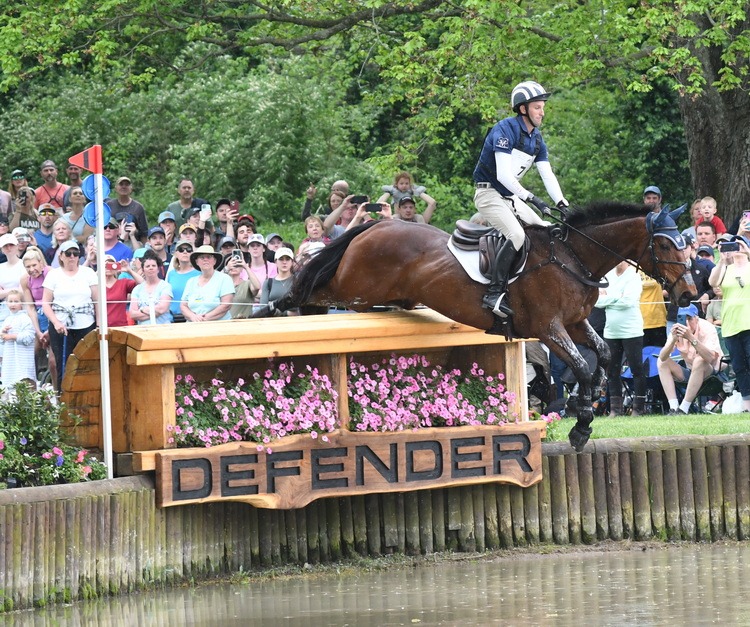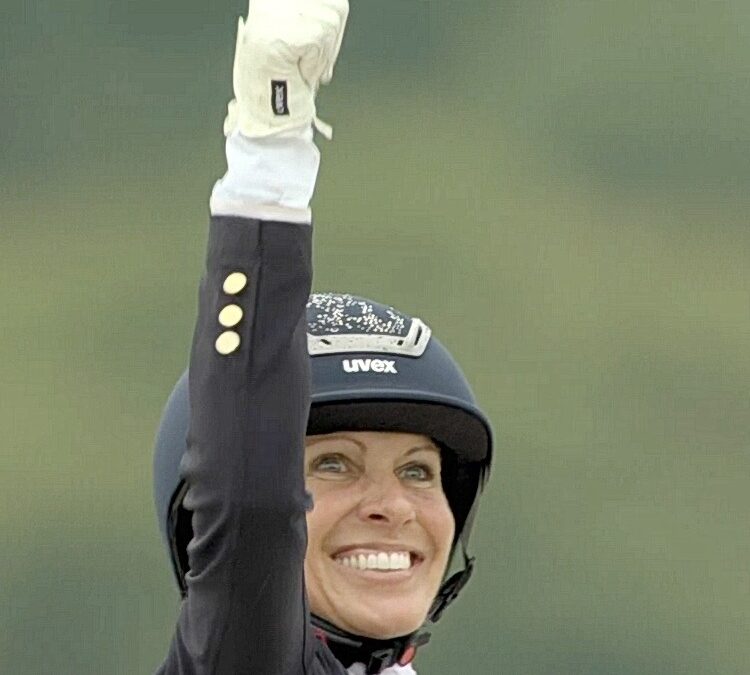
by Nancy Jaffer | Sep 19, 2024
The Rolex Grand Slam of Eventing is looking for another sponsor, as the watchmaker moves to focus on its show jumping involvement, having recently announced a new series in that discipline.
Developed in 1999 for the purpose of encouraging top competitors worldwide to come to what was then the Kentucky 4-star event as well as Britain’s Burghley and Badminton events, (all now 5-stars), the Grand Slam “ties the three majors together in a way that is meaningful for the competitors and makes it interesting for spectators,” said Jim Wolf of the Wolf Sports Group.
“It’s another talking point and newsworthy item for eventing. People follow it. It really is the top of the sport. It’s a very special series which we very much want to continue.”
In 2001, Rolex took over sponsorship of the Grand Slam, which has a $350,000 prize that goes to any rider who wins all three of the events consecutively, but in no particular order.
Testifying to the difficulty of that challenge is the fact that the Grand Slam been achieved only twice, by Pippa Funnell of Great Britain in 2003 and Germany’s three-time individual Olympic gold medalist, Michael Jung, in 2016.

Michael Jung in 2016 at what was then Rolex Kentucky with La Biosthetique Sam on his way to winning the Rolex Grand Slam of Eventing . (Photo © 2016 by Nancy Jaffer)
Jim was on the ground floor of developing the concept with the organizers of Burghley and Badminton when he was the U.S. Equestrian Federation’s executive director for sports programs. Jim continues to consult for USEF and administers the Grand Slam.
Those interested in discussing sponsorship can contact him at wolfsportsgroup@gmail.com.

by Nancy Jaffer | Sep 9, 2024
Allegations of horse abuse involving eventer Andrew McConnon are being investigated by the FEI (international equestrian federation), according to the U.S. Equestrian Federation.
The rider, who finished twenty-seventh on Wakita 54 at Britain’s Defender Burghley 5-star event over the weekend, was the subject of an anonymous report to USEF at the beginning of the summer. (The allegations had nothing to do with Burghley).
The federation was sent material showing the behaviors shortly after the report was made.
“After determining USEF did not have jurisdiction over the matter because it did not involve misconduct at a USEF competition, USEF promptly referred the matter to the FEI, where it is under investigation,” according to a USEF statement.
“The FEI’s jurisdiction and ability to pursue disciplinary action is broader regarding reported incidents of animal abuse occurring outside of licensed competitions. This matter is under the jurisdiction of the FEI and USEF will enforce any disciplinary action taken.”
McConnon, 38, did not respond to a request for comment.
Several sponsors have dropped him in the wake of the allegations.

Andrew McConnon at the Defender Kentucky 5-star event in April. sponsors have dropped McConnon, who is based in North Carolina, in the wake of the allegations.
“Correct Connect will no longer be sponsoring rider Andrew McConnon due to the recently released videos of horse abuse. We do not accept or tolerate abuse of any kind and we are saddened by these recent events,” said one of the sponsors.
Another stated, “World Equestrian Brands has always and will always put the well being of the horse first and foremost, as do all the companies we represent in the U.S. In light of the recent news and videos regarding Andrew McConnnon, he will no longer be part of our trainer team.”
The videos referenced, which have gone viral, include one showing a man hitting a horse in the head and spinning it around after the animal went by a jump and knocked part of it down. Another video showed a horse taking a small jump, then being yanked in the mouth afterward.
Plain Dealing Farm Eventing issued a statement saying, “We have been caught completely by surprise and are truly devastated to learn of this behavior.”
They said one of the horses in the videos is theirs.
“We had absolutely no idea that our horses were being treated in such a way,” the farm said on social media, noting they learned of the situation only when they saw the videos on line.
“There has been a failure to protect there horses and it is unacceptable….we are taking action to rectify this situation.”
The statement added about the horses, “We love them so deeply and are so thankful they are safe at home with us.”
Rebecca Farm and the Broussard Family, which games McConnon a grant that helped him go to Burghley, said in a statement they “have been made aware of allegations of horse abuse regarding one of the 2023 Rebecca Broussard Developing rider Grant recipients.
“The Broussard Family has committed to investing in the sport of Eventing and its athletes for many years and we are deeply shocked and saddened by this information. We do not condone horse abuse in any capacity.”
The statement continued, “The actions committed by the rider in question in no way align with the values the Broussard family believes are synonymous with Eventing and horsemanship. At the time of any rider’s application for a Rebecca Broussard Developing Rider Grant, if there are any open investigations or noted violations of any kind (such as a Yellow Card), the applicant is immediately deemed ineligible. At the time this grant was administered through the USEA Foundation in December of 2023, no information had been made available to us that would disqualify this rider in any way from being a recipient.”
According to the USEF statement, “Abuse in any form, at any time, is unacceptable in our sport.” The USEF noted the federation’s board in June approved a rewrite of a rule involving horse welfare. Effective Dec. 1, 2024, it broadens the jurisdiction USEF can exercise over reports of abuse that occur away from USEF competition.
It also provides an updated description of what constitutes unethical treatment of a horse and provides definitions for both “Participants” who are bound by the rule and a “Covered Horse” expanding the ability of USEF to protect horses.
The rule change proposal went through an extensive review process. Stakeholders and affiliates across all breeds and disciplines provided feedback, which was instrumental in the creation of the final draft of the rule. The rule will apply to reports of misconduct off competition grounds that occur after Dec. 1.
“Social license to operate,” involving public acceptance of horse sports, is a hot topic now. An incident in which Olympic multi-gold dressage medalist Charlotte Dujardin was seen on video hitting a horse repeatedly with a longe whip went viral and resulted in her suspension, as well as headlines around the globe right before the Paris Olympics began.
FEI has begun a “Be a Guardian” campaign aimed at insuring a better life for horses, and is holding a meeting in October to discuss issues facing dressage.
by Nancy Jaffer | Sep 17, 2024
Anyone who had been planning to ride in the cancelled USHJA Outreach Zone 2 Festival – South in New Jersey will be automatically qualified for the USHJA Outreach Zone 2 Festival – West at Swan Lake Stables in Littlestown, Pennsylvania, Sept. 28-29. Those who have not yet qualified can ride in one USHJA Outreach competition to be eligible.
In New Jersey, Outreach qualifiers will be offered at the CJL show at Duncraven Sept. 21 and at Lotus Show Stables in Long Valley Sept. 22.
Read about the Princeton cancellation here.
by Nancy Jaffer | Sep 13, 2024
The sixth annual Farm-to-Table Dinner to benefit the Schiff Natural Lands Trust will feature a dressage freestyle at the U.S. Equestrian Team Foundation stable at Hamilton Farm in Gladstone, N.J., Feb. 21.
Pan American Games medalist Kim Herslow of Upper Creek Farm in Stockton, N.J., will perform a musical ride on Feymar during the event.
Historian and Schiff trustee W. Barry Thomson will give an illustrated presentation about the history of James Cox Brady’s 5,000-acre Hamilton Farm estate, with a focus on its iconic stable and carriage barn, now the headquarters of the United States Equestrian Team Foundation.
Completed in 1917 – and now listed on the New Jersey and National Registers of Historic Places – the elegant Hamilton Farm stable has a rich and varied history.
After serving as the Brady family’s private stable and carriage barn, and frequent meeting place for the Essex Fox Hounds, during World War II the stable’s equestrian-related functions gave way to activities in support of the war effort.
Before the United States entered the war the stable served as a canning factory for fruits and vegetables grown on the estate. Some 36,000 quarts of food were shipped to England during the Battle of Britain and the Blitz.
After Pearl Harbor, the building was converted into a fully staffed and functional emergency hospital, complete with an operating room, for use in the event of an enemy attack on the East Coast. Later, the building served as a convalescent and rehabilitation facility for merchant mariners injured in trans-Atlantic war convoys.
Beginning in 1961, the Hamilton Farm stable reverted to its original use when it became the training center and headquarters for the United States Equestrian Team. Through the years, it has been instrumental in shaping American equestrianism while remaining a beacon for land conservation efforts. Today, Gladstone continues to host events and training clinics, supported by the USET Foundation, ensuring the preservation of its rich legacy and the surrounding landscape for future generations.
The dinner will be prepared by Chef Anthony Bryant. The fresh ingredients for the Farm to Table menu are curated within 10 miles of Schiff Nature Preserve Mendham. A vegetarian/gluten free menu option will also be available.VIP tickets are sold out, but full event tickets ($275) and cocktails and dinner tickets ($225) are available. Click on this link to get tickets.

by Nancy Jaffer | Sep 11, 2024
Friday was the most optimistic day in the recovery of injured eventer Liz Halliday.
The most significant moment of the day was after the Baugh family, came to visit and Liz waved goodbye to them as they were leaving,
She has been seeing all of the #LapforLiz photos and videos.

Liz at the Paris Olympics last month.
Liz’s team thanks
all who are participating in the #LapforLiz . The Foxfire Eventing Team took their first lap Thursday at 7 p.m. Eastern. The team said your notes and pictures have truly helped give Liz the #horsepower she needs to get through this.
They explained they are sending “our horsepower energy to Liz for rapid and complete recovery. We will take a lap in honor of Liz Halliday during every ride from now until she has recovered (or maybe we’ll keep it going). During our lap, we will harness all of the horsepower energy from our equine partners to super-boost our prayers, hopes, and best wishes for her rapid and complete recovery.”
Liz’s friends would like to show Liz everyone’s #LapforLiz to give her much-needed “horsepower energy.” Tag Liz on social media and use the hashtags #LapforLiz and #KeepFightingLiz .
Liz, a member of the U.S. Olympic eventing team in Paris, was injured when her horse fell on cross-country during the American Eventing Championships. Her horse was fine, but she was operated on at the University of Kentucky Medical Center to ease pressure on her brain and continues to recover.
by Nancy Jaffer | Sep 9, 2024
Laparoscopy, the “keyhole” surgery technique that is minimally invasive, is the topic of the Cornell University College of Veterinary Medicine’s first Equine Seminar of the Fall 2024 semester on Sept. 17.
Dr. Rebecca McOnie, instructor in the section of Large Animal Surgery at the Cornell University Hospital for Animals, will describe the advantages of laparoscopy and highlight the candidates for this type of surgery that can avoid a major operation under certain circumstances.
The seminar will cover the limitations of laparoscopy, and when and why to consider laparoscopy for your horse. Dr. McOnie is a linical Instructor finishing a fellowship in large animal soft tissue minimally invasive surgery.
This presentation is part of the Cornell Equine Seminar Series, and will be held from 6-7 p.m. Eastern Time via Zoom. Register in advance at https://bit.ly/ESS-Sept2024








